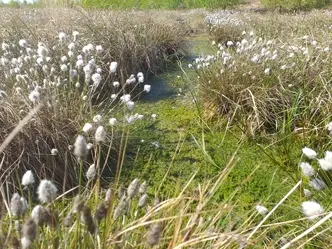What is wetter farming?
- Jenny Bennion

- May 3, 2024
- 3 min read
What is wetter farming? How do you do it? Why would you do it? What can you grow? What else do you need to think about?
This blog first appeared on the Lancashire Wildlife Trust webiste and thanks to Jenny for giving us permission to reproduce it.
Also known as paludiculture or high water table farming, wetter farming is the practice of productive agriculture on wet or re-wetted land, often peatland. Cultivating commercially interesting and financially viable crops on farmland that would naturally have a high water table can be a sustainable and profitable form of agriculture.
Lancashire Wildlife Trust has been working with the Environment Agency to investigate the feasibility of the adoption of wetter farming techniques, considering a number of the questions which this practice raises, investigating that information that is vital for farmers and landowners who are interested in wetter farming.
What is wetter farming?
Whilst the term ‘paludiculture’ is a new one, wetter farming is a traditional agricultural technique working with the natural land conditions. In wetlands such as the Norfolk Broads native reed has been harvested for roof thatch for generations, yet currently much of this land has been drained and we now import 95 per cent of our thatching reed.
Throughout history and especially since the Industrial Revolution large areas of low lying land in the UK was drained and converted to agriculture, a large proportion of which is peatland. This naturally waterlogged land was drained using a mixture of open drainage ditches, below surface land drains and pump systems, and with the addition of fertilisers and other nutrients became productive farmland.
Wetter farming is the practice of growing crops which are suited to wetland conditions. By carefully changing existing land drainage to raise the water table, these crops can then be farmed, ensuring the land remains financially viable.
Why should we be wetter farming?
Draining the water from peatlands causes the carbon that was locked up in the peat to oxidise and be released into the atmosphere as CO2 and other greenhouse gases. In fact, 3 per cent of UK greenhouse gas emissions come from drained lowland agricultural peat. However, if you restore the water table and re-wet the peat, the remaining carbon in the peat is then protected and greenhouse gas emissions can be significantly reduced, sometimes by up to 90 per cent in just one year.
Wetter farming can therefore offer a potential solution for maintaining the profitable agricultural use of lowland peatland whilst drastically lowering the greenhouse gas emissions associated with their current (dryland) use.
How do you start wetter farming?
The key to wetter farming is water – and stopping it from draining out of the field and the farm catchment. By blocking existing drainage ditches, removing land drains and installing bunding (waterproof barriers of compressed peat), water can be kept on the field allowing the land to re-wet. Irrigation and water movement systems can be installed which will allow the water table to be carefully managed to suit the crop being grown. Winter rain can also be stored to help keep land wet during the drier summer months.
What can be grown?
Various trials are being undertaken into different crops which can be grown under wetter farming conditions. These include some food crops such as celery and blueberries, along with more novel products such as bulrushes (typha) whose fluffy seed heads can be converted into a filling for padded jackets and stalks can be used to create fibre board, or sphagnum moss which can either be harvested for use in peat-free composts, or grown as a carbon farm model.
Information on other crop trials can be found at www.paludiculture.org.uk
What else do you need to think about?
There are a number of other factors that need to considered when thinking about wetter farming. Will you need additional water on top of rainfall? Are there any permits or licences you will need to abstract or store water? Could there be any impacts on other areas within the same drainage system?
We have been working closely with the Environment Agency to identify and consider many of these questions which are covered in the above animation. These animations have been developed as an accessible introduction to the topic of wetter farming, providing a starting point for the farmers and landowners of drained agricultural land who want to manage it in a more sustainable way and are considering wetter farming.






Is there evidence that drainage reduced the use of thatching reed rather than the much easier collection of less durable wheat thatching straw that can be harvested at scale? The two may have occurred simultaneously. The real problem is food production on wetted ground and it looks unlikely that this loss can easily be replaced. Biomass in all its guises is not a substitute. Blueberries are widely grown on tabletop systems to improve the production (particularly reliability) and the working conditions of pickers. Celery is also widely grown and at the very least seasonal drying is necessary to achieve low cost. We could add in the European cranberry, reportedly a more tasty cousin of the American version and a number…